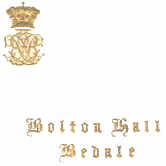
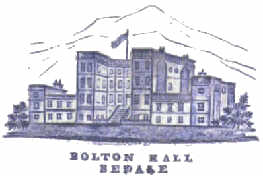 Bolton
Hall in Yorkshire is the home of Lord Bolton.
Bolton
Hall in Yorkshire is the home of Lord Bolton. Page created 14 April 2002
EDWARD LAW
ARMS, CRESTS & MONOGRAMS
PICTORIAL: HOUSES
Pictorial crests are scarce enough, but not rare. The costs involved in producing the dies would have been considerably more than for monograms, crests, addresses or even armorials. It is thought that some may have been produced as samples, exemplars of the high quality which could be achieved. Illustrated here are examples of pictorial crests illustrating houses: others in the category show flora, fauna, machinery and landscapes.

 Bolton
Hall in Yorkshire is the home of Lord Bolton.
Bolton
Hall in Yorkshire is the home of Lord Bolton.
The pictorial vignette with its artfully depicted mountainous background is almost certainly later than the chaste gilt address and crowned monogram which has rather an antique look to it.
The treatment of the mountain in
this depiction of Holyrood Castle, Edinburgh suggests that the
die may have been  executed by the same
executed by the same 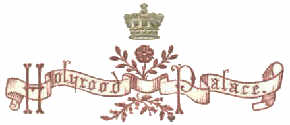 craftsman who engraved the Bolton Hall die.
It is noticeable that the lettering in both is rather poorly done.
The handsome crowned scroll is a more commonly encountered
address for the Palace
craftsman who engraved the Bolton Hall die.
It is noticeable that the lettering in both is rather poorly done.
The handsome crowned scroll is a more commonly encountered
address for the Palace
There is also a strong suggestion
of a common origin in the depictions of Acton Scott and
Rainsthorpe with the illustrations sandwiched between two address
scrolls. The crests are rather heavy and would perhaps have been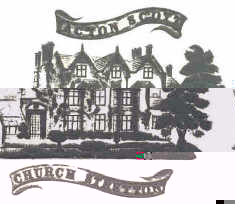
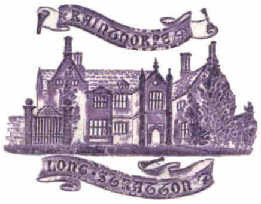 improved and
lightened if the shading had been omitted from the scrolls; that
treatment would certainly have made for easier reading of the
addresses.
improved and
lightened if the shading had been omitted from the scrolls; that
treatment would certainly have made for easier reading of the
addresses.
The Rainsthorpe crest has a manuscript annotation 'Hon F Walpole'. Long Stratton is in Norfolk and Walpole was probably of the family of the Earls of Orford who had seats at Aylsham in Norfolk. Church Stretton is in Staffordshire.
One would not expect to find a
pictorial crest of an American House in a Victorian crest album,
but Agecroft stands in Richmond Virginia. It does now,
having been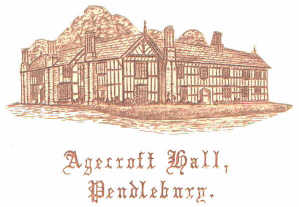 translated there last
century from its original location in the Irwell valley,
Lancashire, just a couple of miles from Manchester. The half
timbered hall had been greatly despoiled by the advances of
industry and the proximity of a railway line, and by the
twentieth century
translated there last
century from its original location in the Irwell valley,
Lancashire, just a couple of miles from Manchester. The half
timbered hall had been greatly despoiled by the advances of
industry and the proximity of a railway line, and by the
twentieth century 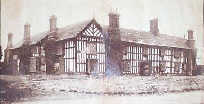 was no longer the
desirable residence which it undoubtedly had been in previous
centuries.
was no longer the
desirable residence which it undoubtedly had been in previous
centuries.
An end of dereliction was in sight in the 1920s when an American couple stepped in; Mr & Mrs T C Williams Jnr. had the hall dismantled and re-erected in Richmond. In the present climate of preservation this would not have been allowed, and indeed it was resisted by some at the time. One must, however, admire the commitment of the Williams's. The old photograph reproduced here shows how faithfully the engraver copied his subject. This handsome depiction was presumably commissioned by the Dauntsey family who were owners of the hall for centuries down to the time of its relocation.
Pictorial letterheads
were also in use in continental Europe.
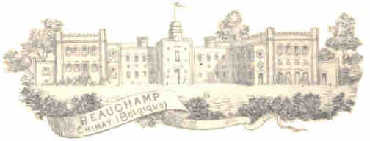
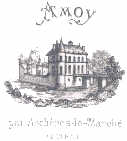 The examples shown here are Beauchamp,
Chimay, Belgium (from a British album) and Amoy, par Aschéres-le-Marché,
(Loiret), France (from a French album).
The examples shown here are Beauchamp,
Chimay, Belgium (from a British album) and Amoy, par Aschéres-le-Marché,
(Loiret), France (from a French album).
 Whilst most of the pictorial crests depict
imposing old houses a couple have been noted where the subject is
a modern Victorian villa in which the owner clearly took as much
pride as the owners of stately houses did of their family homes.
Whilst most of the pictorial crests depict
imposing old houses a couple have been noted where the subject is
a modern Victorian villa in which the owner clearly took as much
pride as the owners of stately houses did of their family homes.
Ferndale, depicted here, was the home of Josiah George Jennings (1810-1882) who, his obituary records, was "universally known as the celebrated engineer of Palace Wharf, Lambeth." The other Victorian villa which has been seen is Fairlawn, Wimbledon Common, also in London.
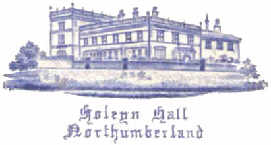
Holeyn Hall was also associated with a celebrated engineer, Sir Charles Parsons, who lived in the house from 1895 and invented there the first multi-stage steam turbine.. The crest illustrated probably originates with the Woods family, previous owners of the hall.
Return to HOME
or to TOPICS PAGE